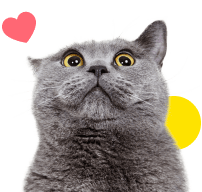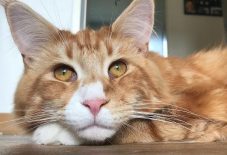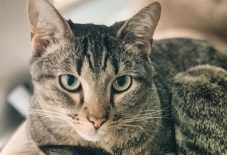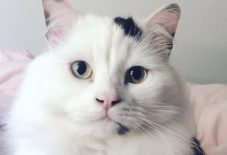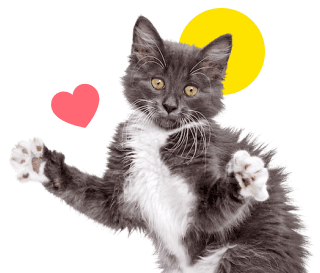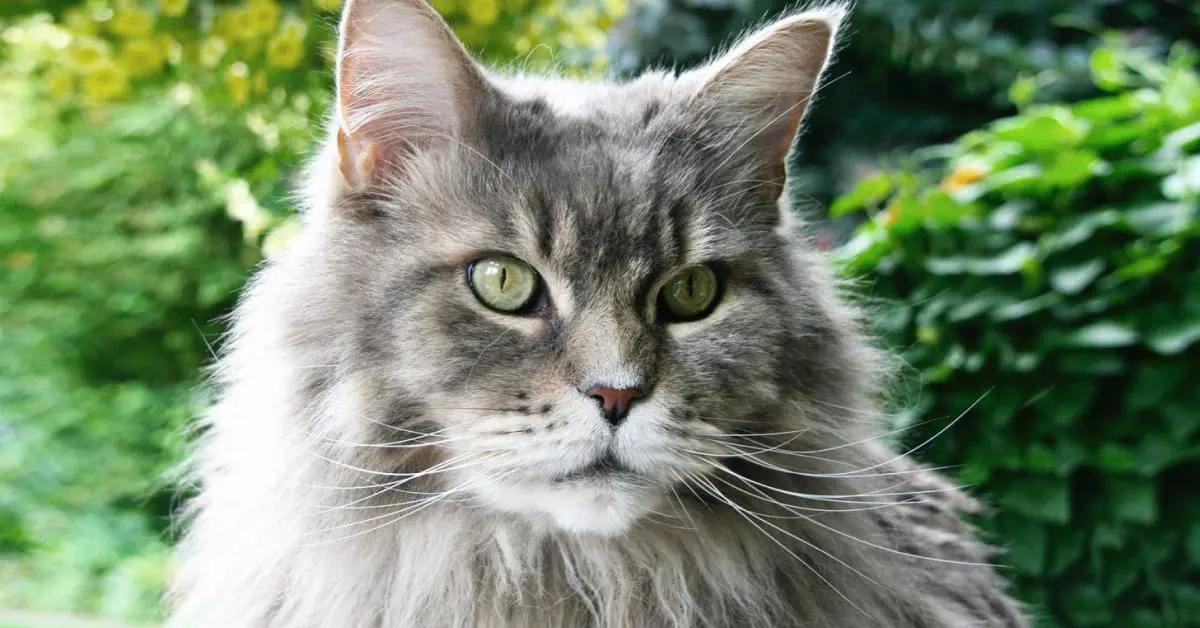
Meet the Maine Coon
Colossal Kitty
Social Butterfly
High Kitty I.Q.
If you’re looking for a big cat with an even bigger heart, I may be the breed for you! I am a wonderful family cat who is super friendly and gets along with everybody. While I may be large, there is a reason my nickname is “gentle giant” – I don’t play rough, so I’m great with kids and other pet-friendly fur babies! I love attention from my humans but I’m not needy – I am totally happy just hanging out solo if you’re busy. Just make sure I have some fun toys to occupy my time. Since I’m really smart, I love puzzle toys that keep my big brain sharp!
I really like to play and, since my breed used to be mousers, I’m the prrrfect kitty if you have some unwanted rodents lurking around your house. If not, that’s cool too. I am just as happy chasing down toys and playing fetch. I’m a pretty chatty cat and I am known for my adorable melodic voice, which is more of a soft chirping or trilling sound than a loud meow. Because of my long, flowing locks, I’m a bit of a shedder, but you can keep some of my fur off your furniture by brushing me regularly (this will also keep me looking furbulous)! With my rugged good looks and friendly personality, it’s no wonder I am one of the most popular cat breeds today.
Ready to learn more about me? Let’s dig in.
Ready to learn more about me? Let’s dig in.
 My Many Looks
My Many Looks
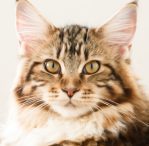
Brown MackerelTabby
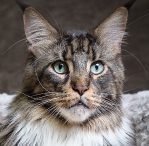
Tortoiseshell
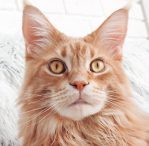
Red & WhiteTabby
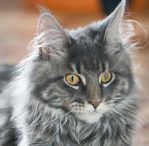
Blue Smoke
 My Breed Characteristics
My Breed Characteristics
 Furbulous Fact
Furbulous Fact
We Maine Coons really earned our gentle giant nickname. The past two Guinness World Record holders for the World’s Longest Cat were both Maine Coons! The first, Stewie, was a gray tabby who measured 48.5 inches long – that’s just over 4 feet! The current (living) record holder is Barivel, who measures 47.2 inches. While Barivel isn’t quite as long as Stewie, he was only 2 years old when he took the title. Since Maine Coons can keep growing until age 4 or 5, Barivel may still become the world’s longest cat!
 As I Grow Up
As I Grow Up
As you can see, we Maine Coons age pretty gracefully. Here are a few key milestones in my growth & development to be aware of as I grow up from a kitten to an adult and senior!
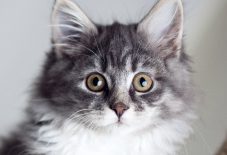
Kitten6 Mo-2 Yrs
It takes me a while to grow to my full size (up to 4 years!), so it’s impawtant not to overfeed me – I’ll get big soon, I promise!
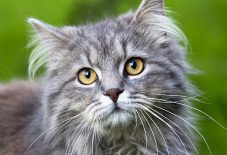
Adult3-4 Years
I may still be growing, but because I’m so large and prone to joint problems, I need lots of playtime to keep me healthy and happy!
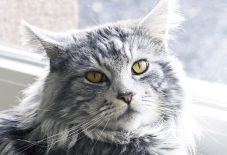
Senior7 Years
I may be slowing down, but maintaining my weight and nutrition is still key – so let’s switch to a food specially formulated for seniors.
 History of My Breed
History of My Breed
While the name Maine Coon makes it pretty clear exactly where I come from, humans have a lot of interesting theories as to how we first came about. Everyone agrees that my breed as it is today is native to the state of Maine – and we are the official state cat of Maine (duh!). But there are a lot of pawsitively fascinating stories about how my earliest ancestors first came to America. Because of my bushy tail and common brown tabby coloring, some humans believe that my ancestors were actually bred with raccoons! Of course, this is not biologically possible, but it did add the “coon” part to my name!
Another famous folk tale surrounding my ancestors’ arrival in the United States is that we descended from six Turkish Angora cats belonging to the Queen of France, Marie Antoinette. As the story goes, the queen was planning to flee to America during the French Revolution, aided by ship captain Stephen Clough from Wiscasset, Maine. While she never made it aboard, her cats did, and so the legend states that the Maine Coon breed resulted from her royal Angoras breeding with domestic cats. While these are all fun stories, the most likely explanation (genetically speaking) is that the earliest Maine Coons were a mix between domestic cats and Norwegian Forest cats who sailed to America with the Vikings and other European sailors!
Wherever we first came from, we were hardy working cats who were good mousers on ships and barn cats on farms. Our fur – including our tufted ears, “snowshoe” paws, and bushy tail – were all designed to keep us warm as we helped our humans in cold and snowy New England winters. As a native American breed, we were hugely popular in the United States... that is until the Persian breed came along and took our spot. By the 1950s, we were almost completely wiped out! Thankfully, a group of humans who were passionate about keeping our breed alive formed the Maine Coon Breeders and Fanciers Association in 1968. We were saved and our breed was officially recognized by the Cat Fanciers’ Association in 1976. Today, we are back on top as the 5th most popular cat breed!
 Pawesome Cats to Parent
Pawesome Cats to Parent
In addition to purebred Maine Coons like me, there are tons of prrrfectly sweet mixed-breed Maine Coons that are looking to find their furever homes. You can learn where to find your next pet below!
 Care Tips
from Dr. Sarah Wooten, Veterinarian
Care Tips
from Dr. Sarah Wooten, Veterinarian 
Get a DNA test & key health screenings.
In addition to yearly wellness exams, recommended vaccines for your cat’s lifestyle, routine blood, urine, and fecal screens, and appropriate parasite prevention, talk to your vet about getting a DNA test + other health screenings for hereditary conditions and breed-specific health issues. For example, it is important to know whether your Maine Coon cat has a genetic Meurs mutation (A31P) that is responsible for heart disease (hypertrophic cardiomyopathy), or spinal muscular atrophy (SMA). Ask your breeder if their breeding cats have tested negative for these diseases.
Groom your cat’s coat daily.
Maine Coons have long hair that mats easily if not cared for. Brush your cat daily with a soft bristle brush – if you start doing this when they’re young it will become part of their grooming routine. Maine Coons grow long hair in between their toes that can be clipped with a pair of small scissors. You can also examine their claws at the same time and clip them if they are too long. If the hair becomes matted, use a fine tooth comb to gently tease out the mat.
Feed the right amount of a high quality diet.
Maine Coons do not have any special dietary requirements when compared to other cats. What is important is to choose a high quality cat food that is certified to be complete and balanced by AAFCO. It is recommended to feed a combination of wet and dry food. Equally as important is to not overfeed Maine Coons because obesity can predispose cats to a large number of chronic diseases. You can use the hand test to determine if your cat is at a healthy weight, or ask your veterinarian what is a good weight for your cat.
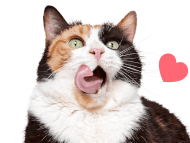
 Why Get Cat Insurance?
from Pumpkin®
Why Get Cat Insurance?
from Pumpkin®
While Maine Coons are a generally healthy breed, cat-astrophes can happen to any cat at any age. If your kitty gets hurt or sick, pet insurance can help you say ‘yes’ to the best care, even when it’s costly. When it comes to shopping for this breed, you’ll want to choose insurance plans like Pumpkin's, which can help cover the costs associated with the hereditary conditions Maine Coons are prone to developing. While a reputable breeder will conduct genetic testing on your kitty’s parents to help minimize the chances of passing down hereditary conditions – they can’t always be avoided. Let’s look at some common ones, and how Pumpkin Cat Insurance plans could help cover the cost of care!
 Hip Dysplasia
Hip Dysplasia
Common in large cat breeds, hip dysplasia occurs when the ball and socket of the hip joint doesn’t develop or work properly, causing joint deterioration, pain, lameness, and/or arthritis. While mild cases are treated with prescription meds and physical therapy, severe ones may require surgery.
- Cost to Treat
- $200-$2,500
- Pumpkin Pays Back*
- $180-$2,250
 Heart Disease
Heart Disease
Maine Coons are genetically predisposed to heart problems, specifically Hypertrophic Cardiomyopathy (HCM). In this condition, the muscle walls of the heart thicken causing a decline in cardiac function. While there is no cure, heart disease can be managed with medication and dietary changes.
- Cost to Treat
- $500-$3,000
- Pumpkin Pays Back*
- $450-$2,700
 Periodontal Disease
Periodontal Disease
This breed is prone to periodontal (gum) disease, which occurs when plaque builds up and forms a layer of tartar that inflames the gums. Left untreated, gums weaken and separate from teeth. While routine brushing, cleanings, and antibiotic gels help treat milder cases, severe ones require surgery.
- Cost to Treat
- $400-$1,200
- Pumpkin Pays Back*
- $360-$1,080
 Obesity
Obesity
Since they’re so big, many owners tend to overfeed Maine Coons (and they’re already prone to obesity)! Overweight cats are more likely to develop other health issues, like diabetes, arthritis, and heart disease. Obesity can be easily treated with dietary changes, meds, and increased exercise.
- Cost to Treat
- $200-$2,000
- Pumpkin Pays Back*
- $180-$1,800
*Example illustrates reimbursement of a covered vet bill at a 90% reimbursement rate, where the annual deductible had already been satisfied and the annual limit had not yet been met. Coverage and reimbursement results vary based on policy options.
